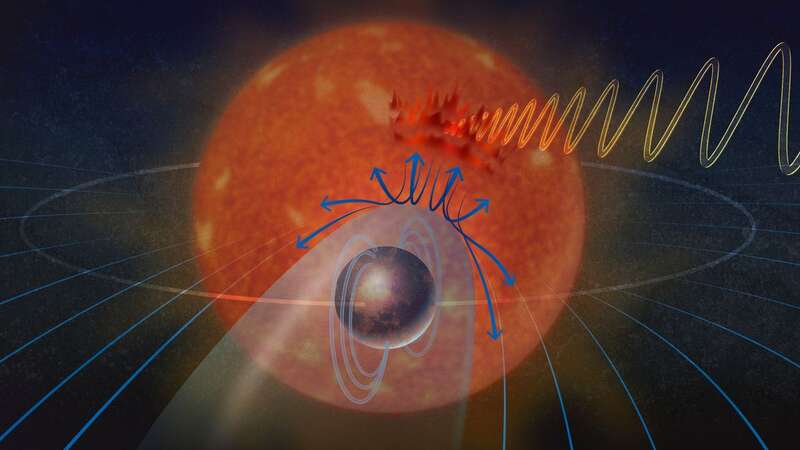
Astronomers have detected a 'coherent' radio signal from an alien planet sparking fresh hope that extraterrestrial life is out there.
The signal is believed to have derived from a distant, Earth-sized planet which could point to it having a similar magnetic field to Earth.
American astronomers have named the rocky exoplanet 'YZ Ceti b' - claiming it is a prime candidate for having an Earth-like magnetic field which could provide vital answers in man's search for alien life.
The astronomers lauded the discovery as important not only in finding a planet that likely has a magnetic field - but also in providing a future method of finding more such planets.
Using a radio telescope, the scientists found exoplanet YZ Ceti b - which is around 70.5 trillion miles away from Earth - to be giving out a repetitive radio signal.
 Aliens not contacted Earth because there's no sign of intelligence, study claims
Aliens not contacted Earth because there's no sign of intelligence, study claims
They theorise that these waves may be generated by interactions between the magnetic field of the exoplanet and the small red dwarf star it orbits, called YZ Ceti.
 Using a radio telescope, the scientists found exoplanet YZ Ceti b - which is around 70.5 trillion miles away from Earth - to be giving out a repetitive radio signal (Getty Images/iStockphoto)
Using a radio telescope, the scientists found exoplanet YZ Ceti b - which is around 70.5 trillion miles away from Earth - to be giving out a repetitive radio signal (Getty Images/iStockphoto)The astronomers lauded the discovery as important not only in finding a planet that likely has a magnetic field - but also in providing a future method of finding more such planets.
The researchers added it could also mean it would be possible to witness the Northern Lights phenomenon - an interaction between magnetic fields and solar weather - on distant planets and stars.
Earth's magnetic field, as well as keeping our compass needles pointing in the same direction, helps preserve our life-sustaining atmosphere by shielding us from and deflecting high-energy particles and plasma blasted from the sun.
A planet's magnetic field can prevent its atmosphere from being worn away over time by particles spewed from its star.
Now, researchers Dr Sebastian Pineda and Assistant Professor Jackie Villadsen have discovered a repeat radio signal given off by the red dwarf star known as YC Ceti, using a radio telescope to observe it in action.
The faraway star is around 12 light years away from Earth. One light year is equivalent to 5.88 trillion miles.
The pair used the Karl G. Jansky Very Large Array, a radio telescope operated by the US National Science Foundation’s National Radio Astronomy Observatory, to better understand the magnetic field interactions between distant stars and their orbiting planets.
The research, published in the scientific journal Nature Astronomy, was also supported by the independent US federal agency the National Science Foundation (NSF).
Joe Pesce, NSF's programme director for the National Radio Astronomy Observatory, said the findings are essential in our search for life on other planets.
 Nasa satellite which spent 39 years in space to fall from sky this weekend
Nasa satellite which spent 39 years in space to fall from sky this weekend
 The astronomers lauded the discovery as important not only in finding a planet that likely has a magnetic field - but also in providing a future method of finding more such planets (Getty Images/iStockphoto)
The astronomers lauded the discovery as important not only in finding a planet that likely has a magnetic field - but also in providing a future method of finding more such planets (Getty Images/iStockphoto)He said: "The search for potentially habitable or life-bearing worlds in other solar systems depends in part on being able to determine if rocky, Earth-like exoplanets actually have magnetic fields.
"This research shows not only that this particular rocky exoplanet likely has a magnetic field, but also provides a promising method to find more."
Dr Pineda, from the University of Colorado on the western coast of the United States, explained the team's excitement at discovering a planet giving off radio waves similar to Earth's.
"We saw the initial burst and it looked beautiful," he said.
"When we saw it again, it was very indicative that, OK - maybe we really have something here.
"Whether a planet survives with an atmosphere or not can depend on whether the planet has a strong magnetic field or not."
Asst Prof Villadsen, an astronomer at Bucknell University on the US east coast, added: "I was seeing this thing that no one has seen happen before."
The researchers believe the radio waves are generated by interactions between the magnetic field of the rocky exoplanet, YC Ceti b, and the star it orbits - YC Ceti.
But for such signals to be detectable over such a distance, they must be very strong.
Whilst magnetic fields have been detected in the past on exoplanets the size of Jupiter, finding those a similar size to Earth requires different techniques.
Because magnetic fields are invisible, it can be a challenge to assert that a faraway planet has one.
But Asst Prof Villadsen explains she and her colleagues are searching for a way to detect them.
She said: "We're looking for planets that are really close to their stars and are a similar size to Earth.
"These planets are way too close to their stars to be somewhere you could live, but because they are so close the planet is kind of ploughing through a bunch of stuff coming off the star.
"If the planet has a magnetic field and it ploughs through enough star stuff, it will cause the star to emit bright radio waves."
Read more similar news:
Comments:
comments powered by Disqus

































